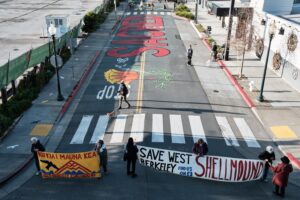Public debate about the plight of protected species at Sharp Park, a San Francisco-owned golf course in Pacifica, has refocused attention on the city’s overall commitment to safeguarding natural diversity.
In late May, the San Francisco Department of the Environment adopted its first biodiversity plan, which would make it city policy to protect rare plants and animals.
The new biodiversity policy follows on Supervisor John Avalos’s recent proposal to turn Sharp Park over to the National Park Service. That idea in turn came as a reaction to environmentalists’ sustained push to aid the park’s federally protected species, the San Francisco garter snake and the California red-legged frog.
“My understanding is that the city has not been as aggressive as it needs to be to protect endangered species there,” Avalos says, echoing claims made by six conservation groups that filed a lawsuit against the city over Sharp Park in early March.
Last Tuesday, the Environment Commission approved the department’s 2011-2013 strategic plan, which for the first time includes a section on biodiversity. The plan would commit the city to a program of promotion and outreach on the importance of indigenous species.
David Assmann, deputy director of the department of environment, said the program is long overdue. The city first published its intention to move in this direction in a sustainability plan adopted by the Board of Supervisors in 1997.
The Natural Areas Program, part of the Recreation and Park Department, has been the city’s only biodiversity program until now. It is tasked with protecting 32 designated natural areas, totaling more than 1,100 acres, which the park department calls “remnants of San Francisco’s historic landscape.” The program employs nine of the department’s 646 staff.
“We’re spread extremely thin,” says Lisa Wayne, who manages the program. “My hope is that we get additional funding so we can do more of what we’re asked to do.” Every unit in the department, she adds, “is woefully understaffed.”
Other environmental issues, from waste reduction to renewable energy, tend to get more attention in the city, says Wayne: “Unfortunately, from the standpoint of the critters and plants that live in our parks, people understand and connect with other forms of the green movement first.”
The Department of the Environment can change that, says Assmann.
“The Natural Areas Program doesn’t have much in the way of resources,” he says. “They’re overwhelmed. They can’t deal with everything they need to deal with. We see ourselves as a program that could help.”
None of this will directly affect the debate over Sharp Park, at least not until the biodiversity plan goes into effect in 2013.
“In the future, I would assume that any policies that come of the program would have an influence on places like Sharp Park,” Assmann says. “But the issue of Sharp Park is imminent. We wouldn’t be weighing in on something like that right now.”
Still, activists hope to use the momentum the city has created on biodiversity protection to propel their case into more prominence.
“San Francisco and its management of Sharp Park Golf Course is not aligned with what we see to be San Francisco values of preserving wildlife,” says Neal Desai, Pacific region associate director for the National Parks Conservation Association. His organization is one of the plaintiffs in the lawsuit, along with the Wild Equity Institute, the Center for Biological Diversity, the Sierra Club, the Surfrider Foundation, and the Sequoia Audubon Society.
The San Francisco Golf Alliance has filed a motion to intervene in the Sharp Park case. If the court consents at a hearing on June 24, the alliance will join the city as a defendant.
The Recreation and Park Department, which owns the 417-acre property in Pacifica, maintains that it can operate the golf course without harming endangered and threatened animals.
Instead of responding directly to requests for comment, park department spokesman Elton Pon sent a February press release that suggested that sport and nature are compatible land uses: “The 18-hole golf course could be redesigned to coexist with viable populations of sensitive species in the long term.”
Assmann said that planning meetings for the new biodiversity policy are already underway, although he anticipates some financial hurdles. “The department doesn’t get any money from the city’s general fund,” he said. “Whenever we want funding we have to find it.”

-1024x768.jpg)




